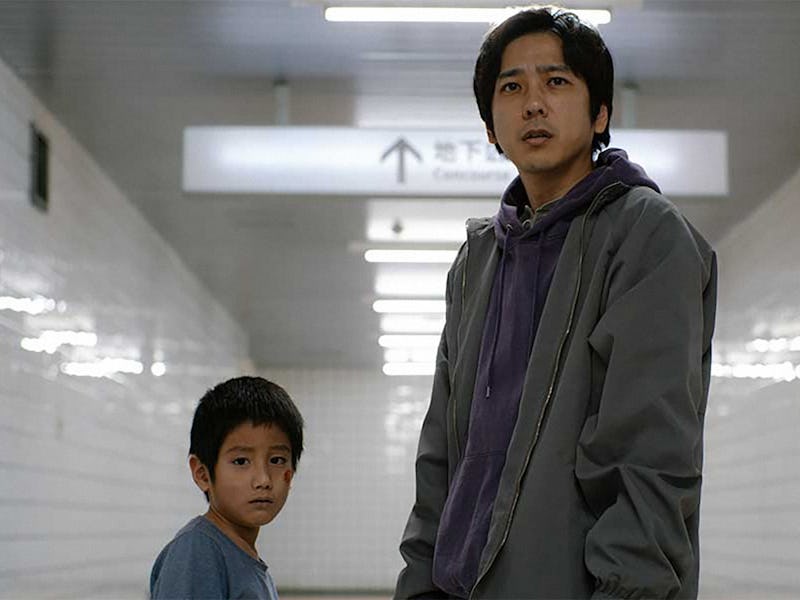Exit 8 Hits Surprisingly Close To Home
The Japanese video game adaptation crafts a heady cautionary tale.

It’s fitting that the hero of Exit 8, Toho’s mind-bending adaptation of the Japanese video game of the same name, is known only as The Lost Man (Ninomiya Kazunari). He seems lost long before getting swept into the maze of this film, and director Genki Kawamura wastes little time projecting his aimlessness onto the viewer. We first meet the Lost Man standing in a crowded subway car, with first-person cinematography planting us firmly in his shoes. Noise-canceling headphones dull his senses, but it’s not enough to diminish the sound of a crying baby... or the disgruntled man scolding the young mother trying to quiet her child. It’s a tough moment to watch, especially as seconds drag by without anyone else in this crammed car standing up for the woman and her baby.
We can count the Lost Man among those detached passengers: he’s avoidant to a fault, perpetually moving forward yet emotionally stagnant otherwise. He’s even ignoring calls from his ex-girlfriend (Nana Komatsu) on his commute to work, though when he finally picks up, it’s easy to see why. As the Lost Man disembarks and heads for the subway exit, she tells him she’s pregnant. She too is stuck, in a way, sitting at the hospital and unsure about keeping her baby. This announcement shakes our unlikely hero to his core: when asked what she should do, or whether he’ll be involved, his answer is awkward silence. The timing of this couldn’t be more inconvenient — but also that’s why it’s perfect. Finally, something he can’t walk away from. Finally, an issue he has to face head-on. And if that metaphor isn’t clear enough, the Lost Man soon finds himself literally lost, trapped in a perpetually repeating subway tunnel with only one way out.
It’s a clever enough conceit to connect the adaptation to an equally straightforward video game. The Exit 8 is the kind of puzzle one could feasibly beat in half an hour. Players are trapped in a never-ending loop. The only way out is through the exit on Level 8 — but to make it out, players need to identify any “anomalies” they encounter in said tunnel. If they find an anomaly, they turn back the way they came and somehow progress to the next level. Some, like blood dripping from the ceiling or an out-of-place doorknob, are easy enough to spot. Others are subtler — but if players progress without noticing them, the levels somehow reset, bringing them back to Level 0.
Exit 8, the film, takes its time establishing this heady set of rules. It takes a few tries for the Lost Man to truly understand the unique purgatory he’s stumbled into. Suffering an asthma attack and determined to meet his ex at the hospital, he doesn’t have any time to wonder about the irony at play. All that matters is making it out, so he adapts an efficient system to identify the anomalies before him — logging the middle-aged man (Yamato Kochi) who walks past him every time a level resets, or all the posters lining the walls in their exact order — and level up as quickly as possible.
In these first few attempts, Exit 8 is pretty much a 1:1 adaptation of its source material, boasting plenty of creepy surprises but otherwise light on plot. Injecting personal stakes into something that’s equal parts walking simulator and pattern recognition test is a puzzle in itself, but Kawamura builds a robust story on this simple foundation by going a different way. When the Lost Man encounters a young boy (Naru Asanuma) trapped in this same exercise, Exit 8 brings him face-to-face with the fears he’s spent his life subconsciously suppressing. It’s less about surface-level (if skin-crawling) scares than it is about addressing much deeper anxieties. Exit 8 transcends its source material, delivering a heartfelt tale of fathers and sons instead.
Exit 8 uses the premise of the game as a springboard into much deeper anxieties.
Exit 8 is a time-loop thriller that manages not to outstay its welcome; at just 95 minutes, it knows exactly where to indulge in its heady premise, what buttons to push, and which threads to leave knotted. The Lost Man is forced to confront a handful of issues that have clearly driven his life off-track, but he will not fix all those problems in one fell swoop. Exit 8 is blessedly realistic in that sense, but surprisingly optimistic in others. It introduces a sci-fi twist to help explain this particular purgatory, allowing the Lost Man to look back on shameful moments in his past and even glimpse a potential future. Each level becomes a lesson for our protagonist, but Exit 8 also wisely shifts its perspective where it counts, exploring the lives of other characters and the choices that trapped them in this maze. It’s a stirring, surprising work, one that explores its premise so thoroughly and intimately, it’s easy to forget how simple a story it’s telling.